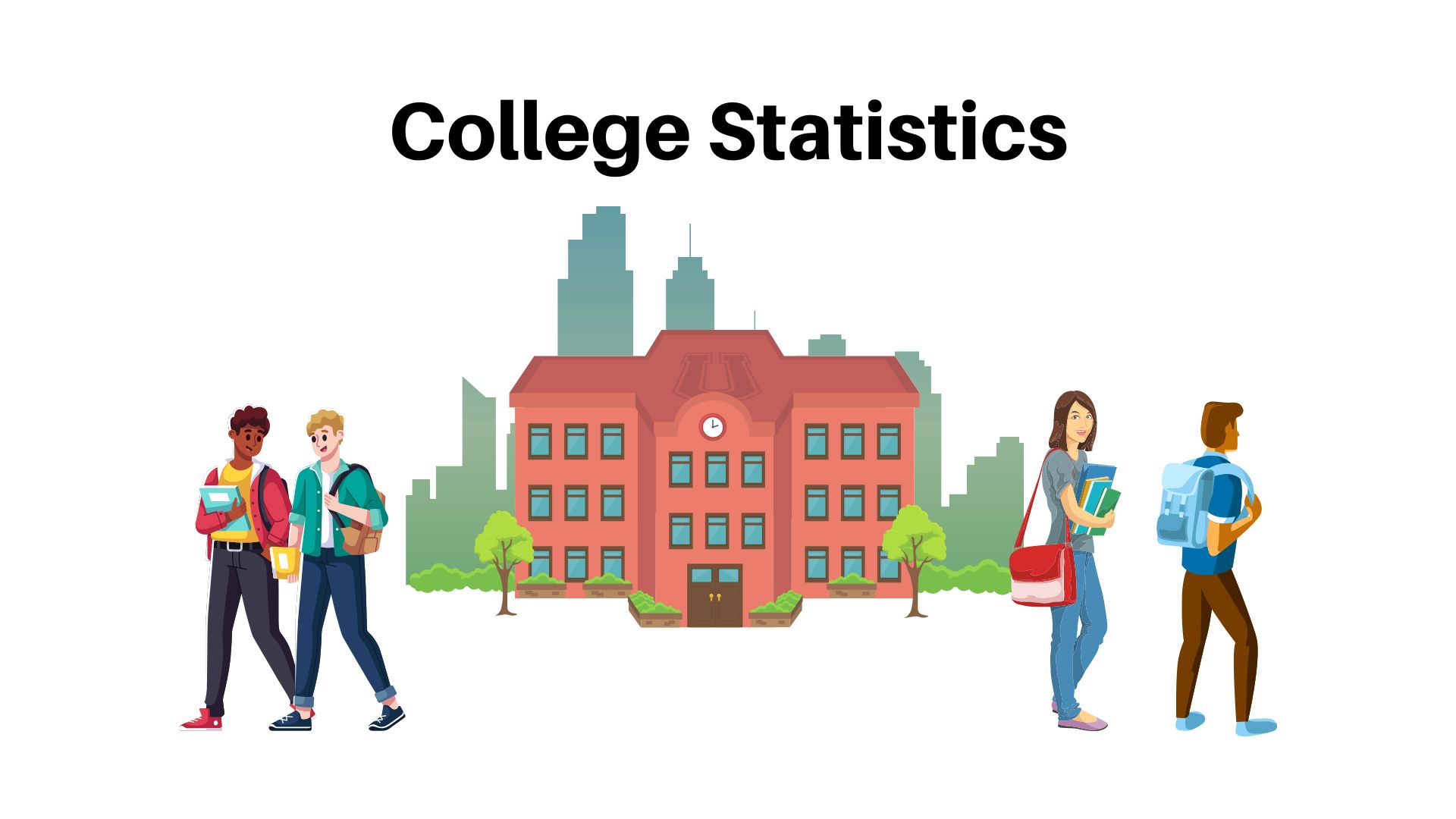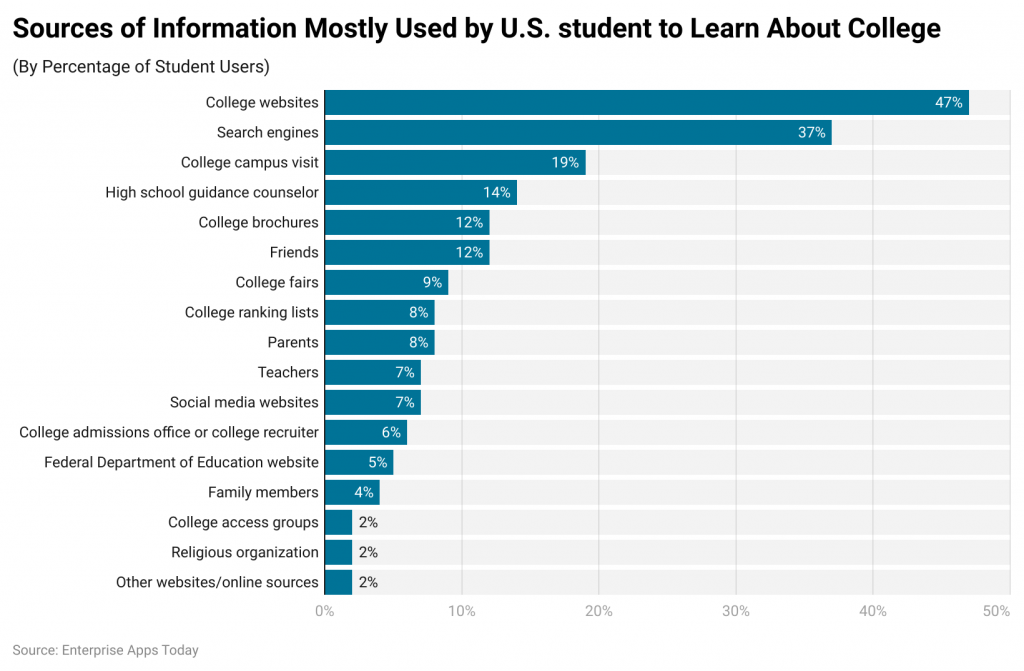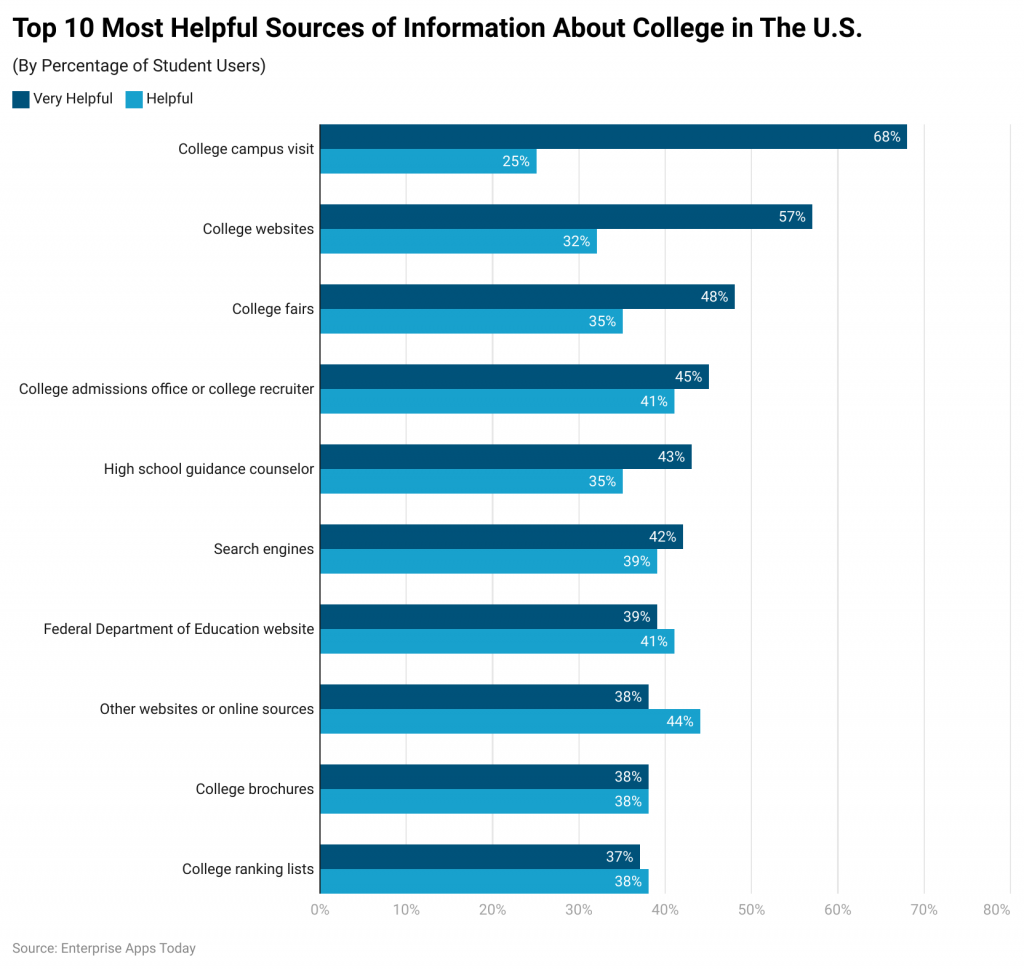77+ College Statistics And Facts Need To Know in 2024

Page Contents
- Introduction
- Key College Statistics (Editor’s choice)
- General Idea About College
- Specializations For Graduation Level
- College Statistics
- Top 10 Colleges / Universities in the World by Rankings
- College Statistics by Sources to Learn About College
- Top 10 Most Helpful Sources of Information About Colleges in The USA
- Conclusion
Introduction
College statistics: College mostly referred to as a university is a graduation step in a person’s life. When it comes to universities or colleges this is the only time when children move out of the house to earn a first degree in their life. College allows students to choose a specialization upon completion of the degree. This specialization allows choosing a job category.
These statistics have a look into the structure of the college and total enrollments with the highest number of applications. It has also been observed that female student prefers higher education to male students. Not to mention, the education quality has improved over the pandemic period as people who were unable to attend college due to work schedules are now able to complete degrees with digital campuses.
Key College Statistics (Editor’s choice)
- As of 2023, total college enrollment of graduate and undergraduate students results in 18,939,568
- 19% of public institution enrollments and 60.78% of full-time enrollment.
- In August 2023, more than 48 thousand enrollments were of foreign students.
- In 2023, Males and females enrolled in higher education are 6.71% and 9.33% respectively.
- In private colleges, the student's age group is more than 25 years, and plus
- Talking in numbers, 11.3 million belong to student female whereas only 8.5 million are male students
- Of students who are undergraduates, 40% drop out of college
- 40% of the students who dropped out of college also had parents who did not finish the college degrees
- 67% of students give importance to attendance, whereas 29% of the students have less importance and 3% give no importance to attendance.
- In the year 2023, the United States of America had a total of 9 million university-level admissions from around the world.
- In past years, Southern New Hampshire University, in Manchester, United Kingdom had the highest number of applications resulting in 300.9%
- The highest acceptance rates are observed at Mason University, University of Missouri, and Virginia Tech resulting in 81.3%, 78.1%, and 70.1% respectively.
- According to the studies, 24% of students apply to only one university for further education while 4% of the students apply to 10 or more colleges.
General Idea About College
Usually, college starts in the autumn season around the globe. A year contains more than 2 semesters per year. It takes around 3 to 4 years to complete the graduation. It usually depends on the student as to when to start a year in college, they can opt for the autumn semester, summer semester, and winter semester. Country-wise, the schedule of the semester changes.
There are two types of colleges: public and private. Public colleges offer scholarships and many other funding options. Whereas private colleges rarely provide any scholarship facilities. Private colleges have higher fees than public colleges. Due to the pandemic, the concept of offline and online campuses came into more focus.
There are many organizations through which universities are providing prerecorded courses, which can be completed online. The fees for which are generally on the lower side. Moreover, actual universities are also into online degrees where now they have separate digital campuses for online or distance education.
Specializations For Graduation Level
There is n number of specializations from which a student can choose his/her favorite subject. Commonly students choose marketing, information technology, statistics, communication, animation, music, cooking, linguistics, politics, and many more. It depends upon the degree which has various options.
College Statistics
- In the United States more than 18.66 million students enrolled in universities and colleges by the year 2023.
- As per 2023 data, the total number of women and men college students is 9.5 million and 7.1 million respectively in the U.S.
- In the U.S. average cost of tuition in private college is around $35,087.
- Whereas, currently total students enrolled in post-secondary institution are 14.2 million.
- LGBTQ students group in college are more than 62%.
- For pursuing a college education, 22.3 million students have borrowed loans.
- In 2023 college students felt depression and anxiety disorders by 33%.
- By the end of 2030, in the United States, around 15.1 million college students are supposed to go to public colleges.
- Around the globe, when degrees are offered full-time and part-time, it has been observed that 83% of the students are full-time degree earners, whereas others belong to part-time students.
- Around 6.6% of adults in the United States of America have their names enrolled for colleges.
- In recent years, the rate of high school graduates has increased by 46.8%
- From the academic year of 2019-2020, around 1,075 enrollments were of foreign students.
- The global rate of graduates from high school has declined to 5.29%
- Around 60.9% resulting in 10 million have been registered as full-time undergraduate and graduate students
- According to the reports, 62% of students continue their education for post-graduation
- As of data from a few years ago, the rate of enrollment increased to 21.02 million.
- Around 71% of the female students enrolled in college whereas, the percentage of male students was at 67% completed graduation after high school.
- Talking in numbers, 11.3 million belong to student female whereas only 8.5 million are male students
- Around the pandemic period, the rate of enrollment reduced to 2.5%
- In private colleges, the student's age group is more than 25 years, and plus
- According to the studies, 6 out of 10 students do not complete the degree
- Of students who are undergraduates, 40% drop out of college
- Considering the financial situations, 31% of the students referred dropping out of college due to bad financial problems
- On the other hand, 54% of the students mentioned struggling between the balance of study and work.
- 40% of the students who dropped out of college also had parents who did not finish the college degrees
- 30% of first-year college students leave their education before reaching the second year.
- Families earning around $1,00,000 a year have their children graduate by the age of 23.
- On the contrary, in families with $35,000 income per annum, 1 out of 7 students graduate by the age of 23.
- The admission choices depend on the availability of the desired program at the university. 74% of the students only apply to those universities where the desired program is listed. On the other hand, 24% of the students have less importance for the availability of the program at the chosen university, whereas 3% do not have any importance at all.
- 67% of students give importance to attendance, whereas 29% of the students have less importance and 3% give no importance to attendance.
- College location is also important to 12% of the students according to their convenience, whereas 41% have lesser importance on this factor before choosing any university.
- The most deciding factor in choosing a college is reputation and funding options
- In the year 2023, the United States of America had a total of 18.66 million university-level admissions from around the world.
- In past years, Southern New Hampshire University, in Manchester, United Kingdom had the highest number of applications resulting in 300.9%
- Whereas UCLA a university in California had an increase in the application by only 66.1% within the same years.
- The highest acceptance rate to study at the university level is in the United States of America.
- On the other hand, the highest acceptance rates are observed at Mason University, University of Missouri, and Virginia Tech resulting in 81.3%, 78.1%, and 70.1% respectively.
- In the year 2019, top universities around the world received the highest number of applications UCLA received 1,02,225 whereas, San Diego and the University of California in Irvine and Berkeley stood with 88,446 applications, 85,092, and 85,044 respectively. The University of Santa Barbara also topped the list with 81,824 applications.
- According to the studies, 24% of students apply to only one university for further education while 4% of the students apply to 10 or more colleges.
- Around 5.2 million students earned degrees in the year 2023.
- Almost 2.8 million students have enrolled in different levels of certification programs such as professional degrees, master’s degrees, doctoral degrees, and simple graduate degrees.Out of which, 24.6% of students earned an associate degree
- 9% of the students have a bachelor’s degree
- On the other hand, 20.8% of students have received their master’s degree
- And 4.7% of the people received their professional and doctorate degrees.
- As per the studies, 19.9% of high school graduates enroll themselves for 2-year college degrees whereas, around 42.8% of the students enroll in 4-year degree programs
- 39% of the students prefer private universities for their further education
- Around 13.87 million resulting in 73% of the students preferred public universities in the last years.
- 66% of the students who earned associate degrees were divided according to specializations such as humanities or general studies up to 36.8%, 17.7% for healthcare, and 11.6% for business studies.
- 8% of the student who has bachelor’s degrees are divided into, 5.9% in biology, psychology, and biomedical science. 8% of students graduated in history and social science. 11.9% of students went for healthcare studies and 19.1% of the students graduated from business-related studies.
- Students who have enrolled for the part-time degree have an average age of 35 years.
- As per the data before the pandemic, for those who continued their education online, the total number of female student were 10,633,118 whereas, male students accounted for only 7,606,756 in the universities.
- The above numbers were 71.3% of female students and 66.9% of male students in overall universities
- As per the reports from QS world university rankings, Harvard University tops the list for most preferred university by the top rankers
- Whereas Stanford University has gained second place in the same topic
- Massachusetts Institute of Technology scored 87.1 for the quality learning experience.
- Students who wish to receive knowledge for university go to search engines resulting in 37% of the total
- In the United States of America, students separately visit the desired college’s website to apply for the degree program
- On the other hand, 12% of the students enroll in colleges by means of referring from friends or relatives, or college fairs and social media networks
- The universities in the United States of America prefer to advertise and promote their college by means of social media networks resulting in 88%
- Today, the top three universities in the world are bagged by The Massachusetts Institute of Technology, Stanford University, and Harvard University quality education.
- Around 29% of universities in the list of top 100 Universities around the world are from the United States of America
- The highest number of degrees was awarded by colleges named Cornell University, Columbia University, Harvard University, Brown University, and Yale University.
- According to the reports, only 1.8% of the bachelor’s degree awardees were unemployed
- Counting for the number of revenues for public universities 20% is earned from tuition and fees, whereas 4% goes to misc. investments. 41%, 7%, and 28% are allotted for government grants, incomes from other businesses, and other misc. revenues respectively.
- Whereas, as far as for private institutions that run for nonprofit purposes earn 30% of revenue from fees, 20% from investments, 11% from government grants, 7% from other businesses, and 31% from misc. revenues.
- On the contrary, universities on the basis of the profit earn 91% revenue from tuition and fees and 4% from government grants.
- According to the reports, studying in the United States of America for international as well as national students is costly. But it offers a high-quality education which is equivalent to high fees.
- In the academic year just before the pandemic, the average college fee for private universities was $36,801 whereas top universities were offering degrees at $50,000.
- As far as studies show that, only 0.6% of students pay more than $60,000 per year for their education. Whereas 12.3% of the students pay fees ranging from $55,000 to $59,000 per year. On the other hand, 13.7% of the students pay fees from $30,000 to $34,000 a year. This range of fees is allotted for nonprofit private universities.
- Whereas public college students pay around $7,000 to $9000 a year and 11% of the students below $7,000.
- Tuition fees for non-profit private colleges are rising every year by 3%
- Considering distance learning around 5.5 million undergrads are currently enrolled in education.
- The pandemic which reduced the number of international students caused a problem of up to $1.8 billion in the year 2020.
- As of recent years, the United States of America has around 4298 educational institutions combining private and public universities.
- As per the reports from college tuition comparison in the year 2020, Touro University and The American Jewish University have the highest rate of graduation resulting in 100% from both universities
- According to College Statistics of Fall postsecondary enrollment of 2023, 73.7% of admissions were made in public institutions out of which 60.8% were full-time enrollment.
- Furthermore, considering undergraduate and graduate students there are more than 21 million admissions that took place in 2023.
You May Also Like To Read
Top 10 Colleges / Universities in the World by Rankings
- Massachusetts Institute of Technology (MIT), Cambridge, USA (99.6)
- Stanford University, Stanford, USA (98.9)
- Harvard University, Cambridge, USA (97.6)
- University of California, Berkeley (UCB), Berkeley, USA (96)
- University of Cambridge, Cambridge, United Kingdom (96)
- University of Oxford, Oxford, United Kingdom (95.8)
- ETH Zurich, Zürich, Switzerland (94.7)
- Imperial College London, London, United Kingdom (92.6)
- Georgia Institute of Technology, Atlanta, United States (92.1)
- Columbia University, New York City, United States (90.2)
College Statistics by Sources to Learn About College

(Source: research.com)
Top 10 Most Helpful Sources of Information About Colleges in The USA
 (Source: research.com)
(Source: research.com)
Conclusion
In today’s competitive world, it is necessary to have a basic degree to survive and earn money. These college statistics have impressive numbers which show that women are keener on higher education than men. Education is powering women to run households as well as the outside world. Even today, there are college dropouts mainly because of financial issues. For such things, the government should look into it to increase the literacy rate up to the graduation level. The more educated people in the country are, the better the future of the country will be.
There’s this trend where students prefer to go international level for their further education, but that respective country should provide such educational opportunities that, leaving the home country will be a second option. Moreover, the United States of America has a maximum preference for higher education from international students, which proves the quality of education provided in the country.
Sources

Barry is a lover of everything technology. Figuring out how the software works and creating content to shed more light on the value it offers users is his favorite pastime. When not evaluating apps or programs, he's busy trying out new healthy recipes, doing yoga, meditating, or taking nature walks with his little one.



